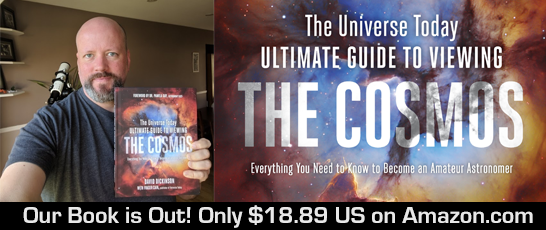November 2019 is a good month for meteors, with the Taurids and Leonids. The Taurids already passed on November 12th, but one of the strongest of the year, the Leonids is due on November 17th - and the pesky Moon shouldn't be as prominent. But the biggest surprise might come a more obscure shower called the Monocerotids. Although they're usually weak, there have been storms in 1935 and 1985, and scientists are predicting that November 22, 2019, might be another of those storm years, with up to 400 meteors per hour streaking overhead. Set that date in your calendar, head outside and look up. Remember, you miss 100% of the meteor storms that you don't try to see. Thanks! Fraser Cain As always, if you have comments or questions, or suggestions on how I can improve this newsletter, please don't hesitate to reply this email or email me at info@universetoday.com. Patrons, don't forget to log in to Universe Today. That'll remove all the ads for you. Join the 843 Patrons who get our videos early, see behind the scenes, and get no ads on Universe Today. Solar energy is the ideal way to power a spacecraft. There's no weather, there's no pesky atmosphere, just pure photons streaming from the Sun to harvest for whatever you need. Well, as long as you're within the inner Solar System. But solar panels are complicated and fragile made of sensitive electronics and glass - not to mention, really heavy. Any spacecraft equipped with solar panels needs to handle the gravity down here on Earth for the construction and testing, then the shaking and high Gs of launch. The solar panels need to unfold perfectly once they get to space. And the total amount of energy you can harvest is limited by the size of your rocket's launch fairing. Maybe there's a new strategy. NASA is currently funding research into a new type of solar panel that can be carried into space as a liquid and then sprayed onto a surface to turn it into a power generating surface. Universe Today Guide to Space Audio: iTunes - RSS Astronomy Cast: iTunes - RSS Weekly Space Hangout: iTunes - RSS NASA's Transiting Exoplanet Survey Satellite has been hard at work watching the entire southern sky for the last year, searching for exoplanets. With this hemisphere completed, it's now going to turn its eyes to the northern skies and search for planets over the upcoming year. To celebrate its work, NASA released this mosaic of the entire southern sky, showing the Milky Way as well as the large and small Magellanic Clouds as seen by TESS: 15,347 separate images. In order to understand the history of our own Milky Way galaxy, astronomers have developed a simulation that recreates its evolution from the Big Bang until now. This latest simulation, developed in Germany required 16,000 separate computer cores working together for an entire year. It encapsulates 230 million light-years in diameter and contains more than 20 billion particles representing dark matter, stars, gas, magnetic fields and supermassive black holes. It feels like yesterday that SpaceX blasted off their first 60 Starlink satellites, but this week the company sent up another 60 on a reused Falcon 9 booster to join the growing constellation. This new batch has a wider broadcast band, in both the Ka and Ku bands. And they've got newly designed components that make sure they complete burn up when they re-enter the Earth's atmosphere at the end of life. The goal is to have 1,440 satellites by the end of 2020. NASA isn't the only country sending a mission to Mars in 2020. China recently tested its new Mars lander in a public test in the mountains in Hebei province, a few hours outside Beijing. This is a region that roughly matches the landscape of Mars where it'll land. The lander demonstrated its ability to hover, avoid obstacles and touch down gently. The mission consists of both an orbiter and a rover with a total of 13 science payloads. The search for life on Mars has been taking an excruciatingly long time. Spirit, Opportunity and even Curiosity have found evidence of past water on Mars, but they don't have the instruments to find life. Well, all this changes, when the Mars 2020 arrives next year. It'll have the instruments to see if life is present today or was ever active in the past, and fortunately, it's going to a place on Mars that's perfect for preserving fossils. Chemical rockets and ion engines have their place, but space agencies are considering propellantless methods of traveling from world to world in the Solar System, harnessing energy from the Sun. Does it make more sense to use solar sails, taking advantage of the photons streaming from the Sun, or is it more efficient to use electric sails, which ply the Sun's solar wind? A new paper from Manasavi Lingam and Avi Loeb weighs the options. I've got a special place in my heart for ion engines. They don't put out a lot of thrust, but they can operate for months and even years to give a spacecraft a huge change in velocity with relatively little fuel. NASA recently tested their new Evolutionary Xenon Thruster - Commercial (NEXT-C) recently, firing it inside one of their vacuum chambers to test how well it'll handle the extreme launch vibrations and temperatures of space. On Monday, November 11, half of the world got a chance to see planet Mercury pass in front of the Sun - a rare Mercury transit. If you missed it, your next chance won't be until 2032. For those of us who got clouded out, telescopes in space got to watch the events unfold. Watching the light of a star dim as a planet passes in front is called the transit method, and it's one of the ways astronomers find planets orbiting other stars. This photograph looks like it's been enhanced with a JJ Abrams-inspired lens flare, but that huge arc in the picture is actually a galaxy. A foreground galaxy cluster is acting like a telescope lens, allowing the Hubble Space Telescope to reveal details of the more distant galaxy that wouldn't normally be visible. The foreground galaxy is 4.6 billion light-years away, while the more distant one is 11 billion light-years, seen as it looked just a few billion years after the Big Bang. Planetary scientists were stunned when they detected unusual concentrations of methane on Mars, a place where that chemical shouldn't last long in the atmosphere. And now they've found a new atmospheric gas to wonder about: molecular oxygen. Although this gas can appear naturally, observations have found that it's spiking to unusual levels as the planet goes through its seasons. Is this a natural process, or could it be a sign of life on the Red Planet? The 50th anniversary of Apollo 11 has come and gone, but buckle up, we're now about to relive all the Apollo missions as they get their 50ths. This week it was exactly 5 decades after the launch of Apollo 12, which brought the next crew of astronauts to the surface of the Moon. This flight was almost aborted because of a lightning strike on the capsule as it was lifting off. Learn about the legacy of this important mission from Heather Archuletta. JAXA's Hayabusa-2 has had a stunningly successful mission at Asteroid Ryugu, deploying several landers, attacking it with an anti-tank weapon, and collecting precious samples of material from beneath its surface. And now the mission is on its way home to Earth, bringing those samples back to the waiting arms of scientists. Its return capsule will enter the atmosphere in December 2020. Here in the Northern Hemisphere, winters can be dark, cold and wet. But there's one object in the sky that almost makes it worthwhile: the Orion Nebula. Here's a wonderful picture of this incredible star-forming region captured by @stobiewankenobi We have featured thousands of astrophotographers on our Instagram page, which has more than 191,000 followers. Want to do a takeover? Use the hashtag #universetoday and I'll check out your photos. Find your way across the night sky. Choose a variety of astronomy gear. Follow the Moon and the planets. Find deep sky objects across the seasons in both hemispheres. Observe comets, asteroids, satellites and space stations. Learn to do astrophotography. Get it on Amazon for only $18.89. Here are some other options.
November Meteors: Taurids, Leonids and a Surprise Monocerotids Outburst
Publisher
Universe Today
Why Launch Solar Panels When You Can Print Them Directly In Space? Building Perovskite Panels
Subscribe to our podcasts:
Audio versions of all the media I upload to my YouTube channel, as well as bonus content, behind the scenes, interviews with Fraser and more
Your weekly facts-based journey through the cosmos, which I co-host with astronomer Dr. Pamela Gay. We have episodes on every concept in space and astronomy, from black holes to the history of astronomy.
A weekly round-up of all the breaking space news. Rocket launches, new discoveries from Hubble, and planetary science by a round table of scientists and space journalists.
TESS Has Now Captured Almost the Entire Southern Sky. Here's a Mosaic Made of 15,347 Photographs
Watch a Simulation of a Galaxy, From the Big Bang Until the Present Day
SpaceX Launches Another 60 Starlink Satellites
China's successfully tests its 2020 Mars lander
Mars 2020 Rover is Going to a Place on Mars That's Perfect for Preserving Fossils
What's the Best Way to Sail From World to World? Electric Sails or Solar Sails?
NASA tests its next generation NEXT-C ion engine
Satellites Watched Mercury's Transit From Space, Confirming That Yes, the Sun Has At Least One Planet
The arc in this image is actually a galaxy, seen thanks to the gravitational lens of a galaxy cluster
Molecular Oxygen on Mars is Behaving Unusually Through the Seasons. A Sign of Life?
Apollo 12 Launched 50 Years Ago
It's Time for Hayabusa-2 to Come Home
Other Interesting Space Stuff
Amazing Astrophotography on @universetoday
Winter Favorite: The Orion Nebula
|


